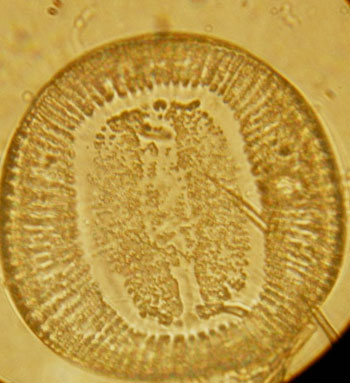
Dedicated to a fine diatomist and great friend, Robert McLaughlin 1922-2012.
Originally hosted on the website of New Mexico State University, College of Agricultural, Consumer and Environmental Services. Archived with permission from Dave Richman, resource editor, and C. Scott Bundy of the NMSU.

The Arid Southwest is hard to define because one could easily add southern California, part of Nevada and Utah to the area and possibly remove the more mountainous parts of Arizona and New Mexico. The Southwest as a floristic province certainly does not end at state lines, or even the Mexican border. However there is some precedent for using the states of Arizona and New Mexico (admittedly artificial entities from a floristic and faunistic standard) and adding the Trans-Pecos of Texas (Figure 1). This area now includes the Arizona-New Mexico Mountains, the United States part of the Chihuahuan Desert, most of the U.S. Sonoran Desert and part of the Mojave Desert (in NW Arizona), the Great Basin Desert (in northeast Arizona and northwest New Mexico), as well as a small part of the Great Plains, primarily in eastern New Mexico. The area is poorly known as far as its diatom flora goes, with only a hand-full of publications.
The aquatic habitats of the arid Southwest are quite varied, despite the relative lack of water. Numerous playa lakes, mostly saline, dot the area. Some are very salty (near Carlsbad, New Mexico, and west of the Guadalupe Mountains in Texas for example) and some are less so. Bitter Lake near Roswell, New Mexico, varies quite a bit in salinity, depending on rainfall (22.8 ppt (01/02), 124 ppt (08/02), 8.2 ppt (01/03), 28 ppt (07/03), 30 ppt (01/04), and 29 ppt (07/04)
USFWS data in Richman 2004). A few (Willcox Playa) are very large. Numerous seeps and springs provide flowing streams at times, especially when snow is melting in the high mountains (Aguirre Springs in the Organ Mountains of New Mexico for example). Some of these streams are permanent and others are nearly so, but most are ephemeral. During drought springs may only provide enough water to fill a surface puddle (Italian Spring in the Rincon Mountains above Tucson, Arizona, for example). Some streams and rivers
(Oak Creek, the Colorado River, the Salt River, the Little Colorado, etc. in Arizona; The Rio Grande and the Pecos River in New Mexico and Texas; Eagle Creek, the Rio Peņasco, the Rio Ruidoso, etc. in New Mexico; and the Gila River in Arizona and New Mexico) are more or less permanent. Non-man made lakes are rare in the Southwest, but there are a number of lakes produced by dams (e.g. Lake Mead, Lake Powell and Rose Canyon Lake in Arizona, Clayton Lake, Elephant Butte Lake, and others in New Mexico). Sinkholes
are another source and Bitter Lake National Wildlife Refuge includes a large number, both dry and with abundant water (Richman 2004, 2006). In addition diatoms found in damp soils are little known. Numerous sites have never been examined to our knowledge - e.g. Ojito Adentro and Cinco Tinajas in the Big Bend of Texas, Dripping Springs in the Organ Mountains and Ash Spring in the San Andres Mountains of New Mexico, Sycamore Creek in the Pajarito Mountains and Cave Creek in the Chiricahua Mountains of Arizona,
just to name a few.

The purpose of our site is to catalog what is known about the diatoms of the arid Southwest and to add to this knowledge as we can. We have tried to use up-to-date nomenclature, although some is still being disputed. For example the family Fragilariaceae has been thoroughly "reworked", with many new genera created, and a few synonomized. Lange-Bertalot synonymized Synedra with Fragilaria, except for the species moved to the new genus Ulnaria, and a few other new genera. We have not always agreed with these changes and have followed what we thought was the more accurate taxonomy. The "State record" notations were derived from Patrick & Reimer (1966, 1975).
Robert McLaughlin, of Santa Fe, New Mexico, provided his unpublished records of extant diatoms in New Mexico. Reference slides are deposited in the California Academy of Sciences, San Francisco, CA and strew slides from seven New Mexico sites are also deposited at the Academy of Natural Sciences Philadelphia, PA. Sites include all records from Abiquiu Lake, Brazos River, Charette Lake, Conchas Lake, Elephant Butte Lake, La Cienaga Lake, McAllister Lake, Navajo Lake, Pecos River, Rio Chama, Rio Grande (all at Rinconada), San Juan River and Storrie Lake. Unpublished records from various sites in Arizona and New Mexico were provided by Richard Carter from material collected by Richard Carter and David B. Richman. These identifications are at times provisional and may be changed if new information shows them to be incorrect.
We want to thank the The National Water-Quality Assessment Program (NAWQA) for the use of Arizona and New Mexico data, which has now been added to the database.
In addition we want to thank Elizabeth Walsh at the University of Texas at El Paso for access to samples mostly from Trans-Pecos Texas collected for her rotifer survey under permits TPWD 02-04 (Hueco Tanks), CAVE-2008-SCI-0005 (Carlsbad Caverns National Monument), and from J. Kargas, Nature Conservancy (Diamond Y and East Sandia). The other samples required no permit. The results from examination of these samples will be posted as Identifications are made (Richard Carter). Strew slides were made by Andrew Potter, Las Cruces, NM. Subsamples and duplicate slides from each of the sites have been deposited with Dr. Marina Potapova, Curator of Diatoms, Academy of Natural Sciences Philadelphia, PA.
David Richman Email: tithonia65@gmail.com